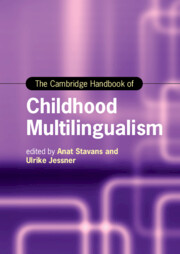Book contents
- The Cambridge Handbook of Childhood Multilingualism
- Cambridge Handbooks in Language and Linguistics
- The Cambridge Handbook of Childhood Multilingualism
- Copyright page
- Contents
- Figures
- Tables
- About the Editors
- Contributors
- Acknowledgments
- Multilingualism Is Not Bilingualism +1: An Introduction
- Part One Becoming and Being a Multilingual Child
- Part Two Cognition and Faculties in Multilinguals
- Part Three Family Language Policy
- Part Four Language(s) and Literacy of Multilingual Children through Schooling
- Part Five Socialization in Childhood Multilingualism
- Part Six Multilingual Children’s Landscape
- 26 Linguistic Landscapes in the Home: Multilingual Children’s Toys, Books and Games
- 27 Linguistic Landscapes in School
- 28 Children’s Perception of Multilingual Landscapes in Interaction
- Subject Index
- Country Index
- Language Index
- References
26 - Linguistic Landscapes in the Home: Multilingual Children’s Toys, Books and Games
from Part Six - Multilingual Children’s Landscape
Published online by Cambridge University Press: 18 August 2022
- The Cambridge Handbook of Childhood Multilingualism
- Cambridge Handbooks in Language and Linguistics
- The Cambridge Handbook of Childhood Multilingualism
- Copyright page
- Contents
- Figures
- Tables
- About the Editors
- Contributors
- Acknowledgments
- Multilingualism Is Not Bilingualism +1: An Introduction
- Part One Becoming and Being a Multilingual Child
- Part Two Cognition and Faculties in Multilinguals
- Part Three Family Language Policy
- Part Four Language(s) and Literacy of Multilingual Children through Schooling
- Part Five Socialization in Childhood Multilingualism
- Part Six Multilingual Children’s Landscape
- 26 Linguistic Landscapes in the Home: Multilingual Children’s Toys, Books and Games
- 27 Linguistic Landscapes in School
- 28 Children’s Perception of Multilingual Landscapes in Interaction
- Subject Index
- Country Index
- Language Index
- References
Summary
This chapter discusses the notion of “homescape” and the role of material homescapes showcasing visible linguistic resources in general, and games and toys more specifically, in the development of the multilingual child. This contribution offers a state of the art regarding the constitution and perception of the linguistic landscapes of infancy and the linguistic, cognitive, affective, social and identity affordances provided by them. We focus particularly on: (i) the multilingual resources of multilingual families and communities engaged with the transmission and maintenance of heritage languages (and therefore involved in multiliteracy practices); (ii) children’s, families’ and educators’ perceptions of multilingual settings and resources available at home; and (iii) their practices and agency within such settings, in order to foster children’s language awareness and literacy across languages. A review of methodologies employed to research homescapes will be critically discussed and a research agenda is outlined, in terms of both potential themes and methodologies.
Keywords
- Type
- Chapter
- Information
- The Cambridge Handbook of Childhood Multilingualism , pp. 605 - 622Publisher: Cambridge University PressPrint publication year: 2022
References
- 1
- Cited by

